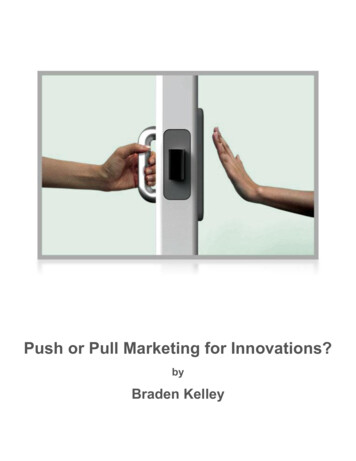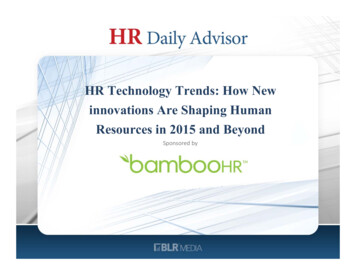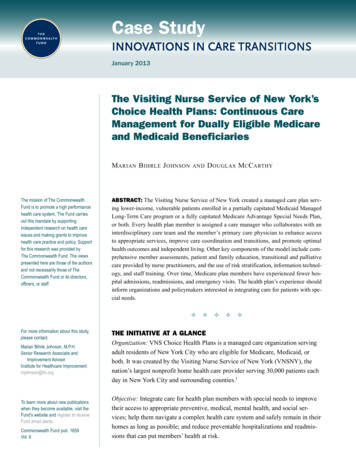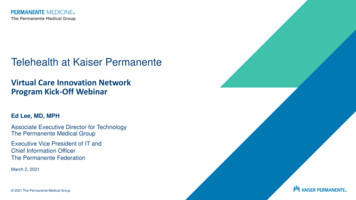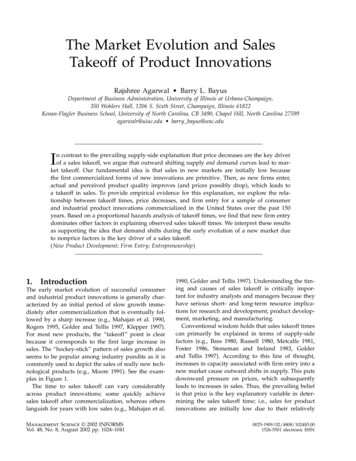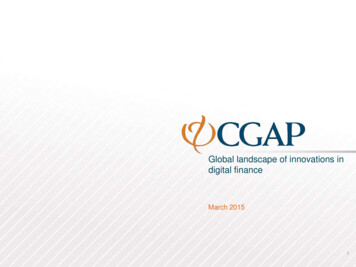
Transcription
Global landscape of innovations indigital financeMarch 20151
Introduction and objectivesMore than half of the world’s adult population, nearly 2.5 billion people, remain unbanked. Technology –particularly the mobile phone – has been used in recent years to extend financial services past thelimits of bank branches and reach new consumers in traditionally underserved segments. Initial effortsfocused on payments but have now grown to include insurance and credit products delivered by digitalchannels, known as “products beyond payments.” Despite a dramatic expansion in the number ofdigital financial service deployments, the offering of these financial services are not new services.Rather, they are existing services migrated to a lower-cost digital channel, therefore offering greaterscale potential. And even then, use of these channels currently remain low.This research seeks to accomplish four objectives:1. Catalog the ways in which technology, especially mobile, can enhance access or use offinancial services2. Provide a comprehensive landscape of the latest innovations in digital finance3. Consider the current and potential impact of these innovations on financial inclusion4. Identify enabling conditions and investments needed to unlock the potential of the sectorCGAP’s Digital Finance Frontiers Initiative sponsored this study, which was conducted by DalbergGlobal Development Advisors during September – December 2014.CGAPWameek Noor (snoor@worldbank.org)Xavier Faz (xfaz@worldbank.org)2
ScopeThis study specifically seeks to surface innovative approaches, features and products that could opennew opportunities for digital financial services that reach the poor.We believe there are features - what we call “digital attributes” - that help enable altogether new solutionsfor digital financial services. Our goal was to scan the landscape in order to:1. Validate these attributes2. Identify where the attributes are being used to deliver new digital financial services todayTo define the “territory” being explored by existing innovators and specifically differentiate from“traditional” financial services being delivered on a mobile channel, we defined the project scope as:WhatHowWhoFinancial products,services or toolsDelivered or deliverablethrough digitalchannelsReach or could reachunderserved segments Savings Loans Insurance Financial management Security Mobile phones ATMs Point-of-sale (PoS)devices Unbanked UnderbankedThroughout this study, we readily acknowledge that the landscape captured here is a snapshot of a pointin time. This space is nascent and rapidly evolving. We look forward to continuing to chart its progress.3
MethodologyDefined innovationlandscapeConducted globalscan for deploymentsValidated findingsbased on deploymentinterviewsDeveloped outputs Collaborated with CGAP on definitions and initial framing for the landscape of the latestinnovations in digital finance Validated and refined initial framing based on 19 interviews with industry experts (incl.those in the tech. start up space)1 Conducted a global scan for deployments meeting selection criteria based on: Desk research Internal CGAP documentation and CGAP crowdsourcing Consultations with industry experts Updated definitions based on expert interviews and landscape review Conducted 34 telephone interviews with selected enterprises to understand businessmodels, customer value proposition, sector-wide trends and challenges and potential forfinancial inclusion impact Collaborated with CGAP to consider how the sector could evolve in the future Further validated findings with follow-up interviews conducted in the final two weeks ofthe study A summary report detailing the industry landscape in 2014 Seven detailed profiles of representative businesses that: Cover leading players in the sector Are representative of overall trends Ensure regional coverage A database of active deploymentsWe identified and analyzed over 300 deployments and used our selection criteria to identify 110 as inscope.Notes: (1) Includes thought leaders, researchers, investors, early stage incubators, accelerators and fintech conference organizers4
Executive summary Digital channels are enabling distinctive new ways of engaging with customers – and their data, but theseinnovations are just beginning to be explored. Through a scan of over 300 deployments across the globe, ourstudy identified over 100 cutting-edge deployments using six unique “digital attributes” (such as digital data trails)made possible through capabilities of the mobile phone. As is expected for a nascent and rapidly evolving sector, wefound a high degree of experimentation and signs of early failures; a majority of players identify as being start-upsstill refining their business models. Entrepreneurs ascribed the challenges to a range of factors from a lack of aproven business case (e.g. in the use of data) to difficulties in consumer acquisition, and broader commercial andregulatory enabling environment itself. Benefits to financial inclusion from these new services are not immediate. Many innovations do not yet targetlow income individuals, require capabilities mostly found in smartphones, and often require a bank account, making itdifficult for the poor to take advantage of these innovations in their current form. Specifically, we found that the vastmajority of products are based in Western markets and tend to reach not un-banked individuals. In addition, giventhe nascent stage of the sector, products are still limited in scope, with an emphasis on providing credit, and do notyet meet the range of customers’ financial needs. However, there is a compelling future vision for how these innovations could benefit the financial lives ofthe poor. Current innovation is driving down transaction costs, expands customer choice, increases customerengagement and helping financial service providers better understand the behavior, and therefore, risk profile ofpotential customers. All of these features can help increase the attractiveness of previously un / underservedcustomers as potential customers. Changes in the ecosystem – and particularly to smartphone penetration rates – could be promoted today tohelp these products proliferate more quickly. Estimated smartphone growth rates and maturing mobile moneyinfrastructure makes us believe that these products could reach the poor in developing economies in the near term.Accelerating this vision requires increased stakeholder commitment (e.g., increased MNO interoperability andcommitment to sharing data), new partnership models, deeper customer understanding and improved regulatoryenvironments supporting mobile money platforms and the use of new technologies.5
ContentsThe role of mobile in financial inclusionAnalysis of the latest innovations in digital financeThe future evolution of digital financeSelected profiles6
More than 50% of the world’s adult population, 2.5 billion individuals,remains unbanked; there are several barriers to financial inclusionAdults with an account at a formal financial institution(%)Key barriers to financial inclusion Lack of financial literacyGender and age discriminationLow income levels / erratic cash flowLack of digital payments ecosystems Long geographic distancesLow population densityMistrust of banking institutionsLack of appropriate products Poor regulatory policies High cost to serve Entrenched cash-based behaviorSource: “Banking on Change: Breaking the Barriers to Financial Inclusion”, Demirguc-Kunt and Klapper (2012), Care7
The extensive reach of mobile money today hints at the potential for themobile platform to increase access to financial services more broadlyAvailability of mobile moneyMobile money product mix(% of developing markets in region w/mobile money, 2014)(% of total mobile money transactions by volume, 2013)2%81%Sub-Saharan Africa2%4%18%Bulk paymentBill payment75%South AsiaMerchant paymentP2P transferLatin America andthe CaribbeanMiddle East andNorth Africa62%East Asia andPacificEurope andCentral AsiaAirtime top-up66%75%58%13% According to the GSMA, mobile money services are nowavailable in 60% of developing countries (88 out of 145) 326 million transfers and payments worth USD 3.2 billionwere processed in June 2013 alone There are now more mobile money accounts than bankaccounts in 11 countriesSource: GSMA Preliminary Insights from the State of the Industry Report (2014); GSMA State of the Industry Report (2013)8
Mobile phones offer a wide range of capabilities that can be applied tofinancial servicesMobile phone capabilities11.Biometrics22.Record of call history3.Camera4.Communication through texting / messaging5.Communication through voice6.Graphical interface7.Internet access8.Location ID9.Near Field Communications (NFC)310. Remote monitoringThese capabilities can beused to provide new typesof financial products,services and tools.For example, biometrics andcamera capabilities can beused to verify customeridentity as part of a bank’sKYC processes.11. Touch screen12. Unique ID413. USSD menu5Many of these features (e.g. biometrics, camera) require or are significantly enhanced on a smartphone.Source: Dalberg analysisNotes: (1) Some features require or are significantly enhanced on a smartphone (2) Hardware or software designed to identify individuals basedon unique characteristics (e.g., voice); (3) Wireless technology that allows two devices (e.g. mobile phones and POS devices) to communicatewith each other; (4) SIM cards are associated with individual customers; (5) Interactive menus which allow for two-way exchange of informationbetween customer and service provider9
Mobile phone capabilities can be used in combination to produce sixunique “digital attributes” with application to financial servicesDigital attributeDigital data trailP2P socialconnectionsSmart and richuser interfaceReal-time customerinteractionInstant verificationRemote sensingExamples ofcapabilities usedDefinitionUsing advanced data analytics on individual mobile call /money patterns and other transactional data to tailorservice offerings and / or segment customers Call historyLocation IDInternet accessUSSD menuLeveraging social networks and P2P platforms to increaseaccess to financial services and customer choice CommunicationNFCInternet accessUSSD menuUsing an intuitive front end interface for customers toenhance user experience , effectively communicaterelevant data and influence behaviorUsing customized, customer triggered, two-way, real-timecommunication to influence customers’ behaviorUsing GPS, cell tower triangulation, camera or biometricdata to verify identity or locationUsing embedded GSM technology to control, or trackmovement and usage of movable assets, to increasecustomer access to and offer tailored financial services Touch screen Graphical interface Camera CommunicationGraphical interfaceCameraBiometrics Internet accessLocation IDCameraBiometrics Remote monitoring Location IDSome attributes are also present in other digital channels; for example, an ATM also enables a smartand rich user interface and can interact with customers in real-time.Source: Interviews with experts; Dalberg analysis10
The digital attributes address a range of barriers to financial inclusion,from expanding financial literacy to building formal financial recordsHow barriers are addressedIllustrative exampleDigital datatrail Increases financial institutions’ understanding ofcustomers Increases customers’ eligibility for financialproducts / services In the absence of formal credit history, a bankuses mobile call data to understand a customer’srisk profile and offer creditP2P socialconnections Expands the network of people with whomcustomers can have financial relationships Provides customers with tailored products Helps build a formal financial record A farmer creates a money pool with familymembers who are scattered across Kenya;borrows money at 0% interest from someone inthe United States Helps tackle issues related to financial literacy Encourages money management / savings An individual can quickly and intuitively use herphone to put away a small amount of money eachday for the purchase of a cowReal-timecustomerinteraction Helps tackle issues related to financial capability Reduces the need for live interactions with bankagents (cuts costs, reduces distance) Student avails of automated, intelligent, two-way textmessage conversations so she and her bank canoffer each other instant, personalized feedback fortailored loan terms and excellent repayment ratesInstantverification Increases financial institutions’ understanding ofcustomers Increases security of transactions An individual takes pictures of documentation andsends to a bank electronically via phone in order toopen a bank account Increases customer eligibility for financial products/ services Provides customers with tailored products Insurance is offered to a customer based onbehavioral patterns (e.g. driving speed) which aretracked through his mobile phoneSmart and richuser interfaceRemotesensingSource: Dalberg analysis11
Growth in smartphone penetration will increase the ability of low-incomeconsumers to take advantage of these capabilitiesSmartphone penetration by regionExamples of how smartphones enhancedigital attributes(% of population)1.2x20122017E440.7x325x201920 Enable user friendly internet use allowingconsumers to access websites and applicationsrequired for many of the products highlighted inthis study, e.g. websites enabling P2P lending Have advanced features, such as camerasand biometric readers needed for identityverification and that can support remote sensing4Sub-Saharan AfricaGlobalLatin AmericaCheaper smartphones. The average price of smartphones fell by16% from over 2011-20131; Mozilla has developed the world’scheapest smartphone at USD 25Zero-rated data content. Initiatives by Internet.org and BandoBradesco (Brazil) enable access to free mobile data. Allow for GPS tracking, enhancing accuracy ofidentity verification Capture more data about consumer behaviorpatterns than basic feature phones (e.g. throughinternet use) Have intuitive, visual screens enablingcustomers to interact with their phone in newways (e.g. through touch and graphics)Shared usage of smartphones. For example, households inMyanmar often share a single smartphone among multiple familymembersSource: Dalberg :analysis “Smartphones and Mobile Money, The Next Generation of Digital Financial Inclusion”, GSMA MMU (2014)Notes: (1) According to estimates by International Data Corp (IDC); (2) “The State of Broadband 2014: Broadband for all”, Broadband Commission (2014)12
ContentsThe role of mobile in financial inclusionAnalysis of the latest innovations in digital finance Summary of findings Digital data trails P2P social connections Smart and rich user interface Real-time customer interaction Instant verification Remote sensingThe future evolution of digital financeSelected profiles13
A comprehensive review of the PBP landscape identified 110deployments; nearly 70% use digital data trails or P2P social connectionsBreakdown of deployments by primaryattribute (n 108)Breakdown of deployments by primary financial needaddressed (n 108)(% of deployments)(% of deployments)244%1%5% 8%43%508%12%2035%5820%19%88%96%80%25%Remote sensingReal-time customer interaction55%100%80%13%10%DigitalP2P social Smart anddata trail connections rich userinterface1Real time Location /customerIDinteraction verificationRemotesensingLocation / ID verificationSmart and rich user interfaceInsureManage financesDigital data trailSaveBorrowP2P social connectionsSecure transactionsThis data indicates a high level of entrepreneurial activity in P2P social connections and digital data trailsvis-à-vis other digital attributes and a strong focus on providing credit.Source: CGAP PBP deployment database; Dalberg analysisNotes: We have allocated one primary digital attribute and financial need served to each deployment that is fundamental to their valueproposition, although some might leverage secondary digital attributes and/or address secondary financial needs; for e.g. P2P creditmarketplaces are considered to address the need to borrow (and not to invest), for the purpose of this study14
While the majority of overall activity is concentrated in North Americaand Europe, P2P platforms have spread across the globeNumber and breakdown of deployments by region1Remote sensingEuropeNorth America26%3924Real time customer interactionLocation / ID verificationSmart and rich user interface17% 17%Digital data trail3%10%P2P social connections15%67%MENA15%250% 50%Asia31%Latin America6%225%5%6%6%39%44%18Africa41%5%5%5% 30%55%50%20Australasia425%75% North America, Europe and Australasia are dominated by products using digital data trails, P2P social connections and smart andrich user interface, but there are signs of innovation across attributes, especially in the United States In Africa, the proliferation of digital data trails using mobile money / call data is likely due to the relatively high levels of mobile moneypenetration in certain markets; relatively lower levels in Asia where mobile money has had less uptake In middle income markets in LAC, digital data trails and P2P social connections are possible because of high levels of internetconnectivity; overall volume of activity seems to be low, however, and experts cite cultural preference for in-person transactions Relatively low levels of innovation in MENA, due to traditionally conservative lending practices by banking institutionsSource: CGAP deployment database; Interviews with experts; Dalberg analysisNotes: (1) Shows geographic breakdown of 108 identified deployments. However, the sum across regions is 129 as there are somedeployments that are active in multiple regions; North America includes US and Canada; Mexico is included under Latin America15
Enterprises and experts agree that while it holds promise, the sector isstill at a very early stageDigital data trail“They’re small players are still trying to figure out how to bring them [data-based lendingproducts] to market, get them to scale.”– Thought leaderP2P socialconnections“Volume is growing, but players are still trying to figure out how to lend intelligently on P2Pplatforms.”– Impact investorSmart and richuser interface“Tailoring products for poor people will require creating tools allowing for masscustomization you need to be able to drag and drop payments to a person, event, etc.”– Thought leaderReal timecustomerinteraction“There are only a few financial institutions that are willing to try something that isinnovative in a field they are uncomfortable with. This is our biggest barrier to growth.”– Deployment using real time customer interactionInstantverification“We’ve seen the wave of biometrics startups beginning two years ago it’s going to be multipleyears of due diligence and testing before they establish accuracy and usage.”– Conference organizerRemotesensing“The provision of credit isn’t happening because pay-as-you-go energy companies are stillearly stage. They need to first prove their business model, before they can think ofexpanding to other products.”– Deployment with pay-as-you go modelThe majority of organizations we spoke with were founded in the last 2-3 years and self-identify asstart-ups still refining their business models.Source: Interviews with experts; Interviews with deployments16
A number of factors keep the sector from notably influencing financialinclusion todayUnderbanked, notunbankedLimited product range Many deployments explicitly target underbanked individuals or those who don’t have a formalcredit history, but very rarely target the completely unbanked Customers benefitting from P2P transactions, savings/money management tools and digitaldata trails utilizing big data usually
Current innovation is driving down transaction costs, expands customer choice, increases customer engagement and helping financial service providers better understand the behavior, and therefore, risk profile



